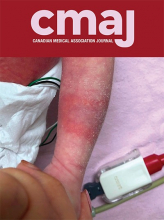A 39-year-old woman with a body mass index of 25.8 presented to our internal medicine clinic with a 5-day history of left lower quadrant abdominal pain, abdominal fullness and frequent urination. The pain was dull, nonradiating, persistent and exacerbated by urination, walking and laughing, but not by meals. She had no fever, vomiting, diarrhea, constipation or hematochezia, and had not previously experienced similar symptoms. Her vital signs were normal. She had localized tenderness in the left lower quadrant of the abdomen without rebound tenderness, which did not increase when she tensed her abdominal wall (negative Carnett sign). Computed tomography showed a spindle-shaped, 3 cm–long fatty mass adjacent to the sigmoid colon, surrounded by a linear high-absorption ring (hyperattenuating ring sign) (Figure 1) and inflammation around the mass that spread to the bladder. We diagnosed epiploic appendagitis. Her symptoms resolved in 7 days with conservative management.
Contrast-enhanced abdominal computed tomography scan of a 39-year-old woman with epiploic appendagitis, showing the characteristic hyperattenuating ring sign (arrowheads) adjacent to the sigmoid colon (arrow). (A) Coronal view and (B) sagittal view.
Epiploic appendages are peritoneal pouches containing adipose tissue and blood vessels that protrude from the anti-mesenteric border of the colon.1,2 Epiploic appendagitis is characterized by inflammation and ischemic necrosis of epiploic appendages due to torsion or venous thrombosis.1,2 The annual incidence is 8.8 per million population.1 Risk factors include obesity, strenuous exercise and the presence of an abdominal hernia.1,2 The pain is typically acute, localized, nonradiating and persistent.1 When the inflamed epiploic appendages adhere to the peritoneum, pain may be exacerbated by movement, deep breathing and coughing.1,2 Fever, nausea, vomiting, diarrhea, constipation and abdominal fullness seldom occur.1 If inflammation spreads to the bladder, it can cause lower urinary tract symptoms and be misdiagnosed as a urinary tract infection.
The differential diagnosis includes appendicitis and diverticulitis. Computed tomography has higher sensitivity and specificity than ultrasonography for the diagnosis of epiploic appendagitis.3 The main computed tomography findings are a hyperattenuating ring sign and a central dot sign.1 The condition is self-limiting and can be managed using anti-inflammatory analgesics and usually improves within 14 days.1 Complications such as adhesions, bowel obstruction and intussusception seldom occur.1–3 Awareness of this condition can reduce unnecessary hospital admission, surgery and antibiotic use.
Footnotes
Competing interests: None declared.
This article has been peer reviewed.
The authors have obtained patient consent.
This is an Open Access article distributed in accordance with the terms of the Creative Commons Attribution (CC BY-NC-ND 4.0) licence, which permits use, distribution and reproduction in any medium, provided that the original publication is properly cited, the use is noncommercial (i.e., research or educational use), and no modifications or adaptations are made. See: https://creativecommons.org/licenses/by-nc-nd/4.0/









